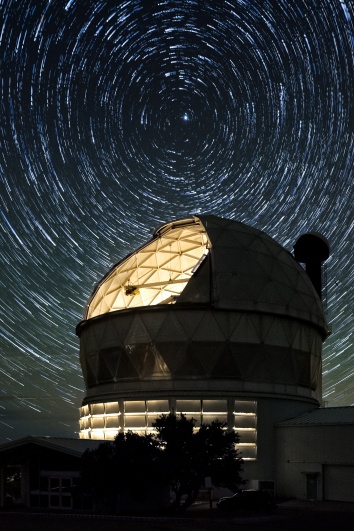Hobby-Eberly Telescope reaches 25th anniversary milestone
10 October 2022
Reflections on 25 Years of Science
The Hobby-Eberly telescope (HET) at The University of Texas at Austin's McDonald Observatory has reached a milestone — 25 years of service. One of the world's largest optical telescopes, the HET captures light from stars and distant galaxies to help astronomers solve the mysteries of the cosmos.
“This year marks an important milestone for the Hobby-Eberly telescope,” said Taft Armandroff, the Director of McDonald Observatory and HET Board Chair. “The HET provides the resources that our faculty, students, and researchers from partner institutions use to do cutting-edge science.”
First dedicated in 1997, the HET rotates on a cushion of air to train its 11-meter (433-inch) honeycombed mirror 55 degrees above the horizon to scan the universe. The telescope received an upgrade in 2016, expanding its field-of-view to capture a section of the night sky 120 times larger than before. With the upgrade, the HET has been instrumental in some remarkable discoveries.
The HET is a collaborative effort among four institutions: The University of Texas at Austin, Penn State University, Ludwig-Maximilians-Universität München, and Georg-August-Universität Göttingen.
Pushing the Limits of Investigation
A map of the cosmos
The Hobby-Eberly Telescope Dark Energy Experiment (HETDEX) is an international collaboration that is probing dark energy by building the largest three-dimensional map of the universe. By training the HET on two regions of the sky — near the Big Dipper and Orion — the telescope is capturing the cosmic fingerprint of the light from 2.5 million galaxies. Astronomers are using the Visible Integral-field Replicable Unit Spectrograph to comb through the spectra gathered during these scans to construct a map of the cosmos. These efforts will inform critical questions, like how and why the expansion of the universe is speeding up over time.
“The international HETDEX program involves not only the four university partners but dozens of additional scientists at several institutions from around the world,” said Donald Schneider, distinguished professor in the Department of Astronomy and Astrophysics at Penn State University and a HET Board member.
Searching for Goldilocks planets
HET has also played an integral role in finding Earth-sized planets that circulate sun-like stars. The Habitable Zone Planet Finder aims to identify exoplanets that lie within habitable zones capable of supporting liquid water on the surface. In one search, they identified K2-25b, a planet the size of Neptune orbiting a M-dwarf star. Using high-resolution spectroscopy, the researchers were able to determine the angle between the star’s equator and the orbit of the planet, which offers insights into the formation and evolution of planetary systems.
“A lot of the public thinks science has these eureka moments, but most major scientific discoveries are met with ‘hmm that’s funny,’” said Bill Cochran, research professor at UT Austin and Chair of HET Users Committee. “To me, whether or not a planet is currently habitable is not the right question. I am interested in how the planet evolved, and I want to use the findings with the Habitable Zone Planet Finder to pursue these questions with my colleagues in different disciplines.”
Searching for monsters
More than 220 million light-years away in the constellation Perseus, HET identified and measured the mass of an enormous black hole in the NGC 1277 galaxy as part of the HET Massive Galaxy Survey. This information is critical because astronomers have only measured the mass of about 100 black holes. The lack of data is not correlated to the level of interest in these dark monsters. The survey aims to identify which galaxies to focus limited resources to gather more data that could inform how black holes and galaxies form and evolve.
Solving a supernova mystery
Numerous telescopes around the world observed the supernova of 2014C, but the stories constructed from each source did not present a coherent picture. The mystery was solved when HET researchers measured variations in the dying star’s brightness and spectrum and developed a model that revealed the star did not explode outward in a spherical direction. During the event, the gas from 2014C, which is part of a binary star system, merged with its neighbor, sharing the gaseous envelope in the expanding disc. As one star exploded, it collided with and slid along the gaseous boundary layer, producing the unusual results obtained around the world for this unique supernova event.
“Hobby-Eberly is unlike any other telescope,” said Armandroff. “These few examples provide a sample of the work being accomplished as researchers make use of its large collecting area, wide field of view, and queue scheduling, laying the groundwork for discoveries yet to be made.”






